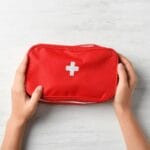Have you ever woken up with a swollen eyelid? Or have you been going about your day, only for a concerned family member or colleague to mention your eyelid swelling? You’ll be pleased to hear that this medical condition is incredibly common, and swelling usually reduces after 24 hours, but that can depend on the cause of your swollen eyelid. You’ll find a useful article on swollen eyelids from allaboutvision.com, click the link to check it out.
What is a swollen eyelid?
When the excess fluid in your eyelid area builds it can become inflamed and infected, leading to substantial swelling and discomfort. It can affect the upper or lower eyelid and understanding why you might have developed a swollen eyelid can help determine what treatment you should take or whether you should seek medical intervention.
What could have caused your swollen eyelid?
There are many reasons why your eyelid might be swelling, the most common include:
- Allergies and hay fever
- Pink eye/conjunctivitis
- A stye (red bump on the eyelid or waterline)
- Trauma or a head injury
- Cellulitis
- An eye infection
When should you see a doctor?
In some circumstances, you should seek medical attention, so you can accurately determine what has caused your swollen eyelid and if you need treatment. Seek medical attention if your swollen eyelid is the result of trauma or a head injury. If you have persistent pain in your eyeball, if your vision is blurred or getting worse, or if you feel as though there is something in your eye or you can’t move your eyeball as you normally would then you should get the problem looked at. Shaking, high temperature, confusion or dizziness could be a sign of a serious infection. If you’re experiencing floaters or visual disturbances in your vision, then seek medical attention immediately.
Can I treat a swollen eyelid at home?
Most cases of swollen eyelids can be relieved with treatment at home. Of course, if your condition worsens, go to the emergency room. Consider the following ideas to help combat the discomfort and reduce swelling.
Remove your contact lenses
If your eyelid is beginning to swell, then take your lenses out as soon as possible. This removes the possibility of bacteria being stuck behind your lens and making the situation worse. Removing them will also reduce discomfort.
Keep your head elevated at night
If your eyelid swelling is the result of hay fever, then sleeping with your head elevated at night will help reduce eyelid swelling.
Use a warm compress
This treatment is ideal if you’re suffering from a stye that has led to eyelid swelling. Placing a clean, warm washcloth over your eye will help reduce swelling and relieve discomfort.
Wipe away gunk
If your swelling comes with discharge and gunge, like in pink eye cases, keep your eyelids clean and regularly wash away the discharge with clean cotton balls and warm water. Keep your pillowcase and bedding clean.
Say no to makeup
Consider going makeup-free while you wait for the swelling to go down. If you have contracted bacterial conjunctivitis or a stye due to infected cosmetics then pausing your makeup use will help.
Remember – if you’re concerned about your vision, call your doctor immediately.





